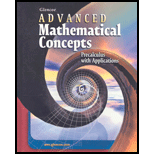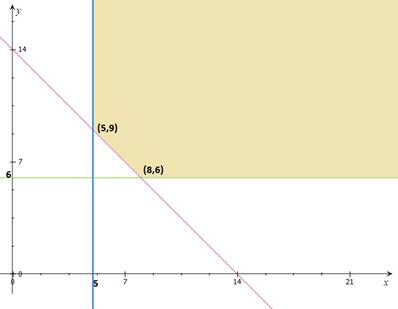
(a)
To find: The inequality to represent the number of day-shift workers, the night-shift workers, and the total number of workers needed.
(a)
Answer to Problem 13E
The inequality is
Explanation of Solution
Given:
Angela’s pizza is open from noon to midnight day.
Employees work for 8-hour shifts from noon to 8 P.M. or 4 P.M. to midnight.
The inequality that represent the number of day-shift workers, the night-shift workers, and the total number of workers needed as below.
Let
And
Therefore the inequality is given above.
(b)
To find: The graph the system of inequality.
(b)
Answer to Problem 13E
The graph is given below.
Explanation of Solution
The graph of the above inequality is given below:

In order to check the shaded region contains origin or not, check after substituting
The shaded region does not contains origin.
Therefore, the graph is given above.
(c)
To find: The function to represent the daily cost of payroll.
(c)
Answer to Problem 13E
The function to represent the daily cost of payroll is
Explanation of Solution
The cost of payment that are paid to employees those work between noon and 4P.M is $5.50 per hour.
The cost of payment that are paid to employees those work between 4P.M and mid-night is $7.50 per hour.
So the function to represent the daily cost of payroll is given as:
Here
And
Therefore the function to represent the daily cost of payroll is
(d)
To find: The number of day-shift workers and night-shift workers that should be scheduled to minimise to cost.
(d)
Answer to Problem 13E
The number of cups of each type of puppy: 1.5 cups of Good Start and
Explanation of Solution
In order to minimise the cost, test each point in the minimizing function, that are shown on the boundary of the graph.
The minimum cost attains at the point
Therefore the number of day-shift workers is 8 and night-shift workers is 6.
(e)
To find: The minimum cost.
(e)
Answer to Problem 13E
The minimum cost is
Explanation of Solution
The minimum cost at
Therefore, the minimum cost is
Chapter 2 Solutions
Advanced Mathematical Concepts: Precalculus with Applications, Student Edition
Additional Math Textbook Solutions
Single Variable Calculus: Early Transcendentals (2nd Edition) - Standalone book
Thomas' Calculus: Early Transcendentals (14th Edition)
University Calculus: Early Transcendentals (3rd Edition)
University Calculus: Early Transcendentals (4th Edition)
 Calculus: Early TranscendentalsCalculusISBN:9781285741550Author:James StewartPublisher:Cengage Learning
Calculus: Early TranscendentalsCalculusISBN:9781285741550Author:James StewartPublisher:Cengage Learning Thomas' Calculus (14th Edition)CalculusISBN:9780134438986Author:Joel R. Hass, Christopher E. Heil, Maurice D. WeirPublisher:PEARSON
Thomas' Calculus (14th Edition)CalculusISBN:9780134438986Author:Joel R. Hass, Christopher E. Heil, Maurice D. WeirPublisher:PEARSON Calculus: Early Transcendentals (3rd Edition)CalculusISBN:9780134763644Author:William L. Briggs, Lyle Cochran, Bernard Gillett, Eric SchulzPublisher:PEARSON
Calculus: Early Transcendentals (3rd Edition)CalculusISBN:9780134763644Author:William L. Briggs, Lyle Cochran, Bernard Gillett, Eric SchulzPublisher:PEARSON Calculus: Early TranscendentalsCalculusISBN:9781319050740Author:Jon Rogawski, Colin Adams, Robert FranzosaPublisher:W. H. Freeman
Calculus: Early TranscendentalsCalculusISBN:9781319050740Author:Jon Rogawski, Colin Adams, Robert FranzosaPublisher:W. H. Freeman
 Calculus: Early Transcendental FunctionsCalculusISBN:9781337552516Author:Ron Larson, Bruce H. EdwardsPublisher:Cengage Learning
Calculus: Early Transcendental FunctionsCalculusISBN:9781337552516Author:Ron Larson, Bruce H. EdwardsPublisher:Cengage Learning





